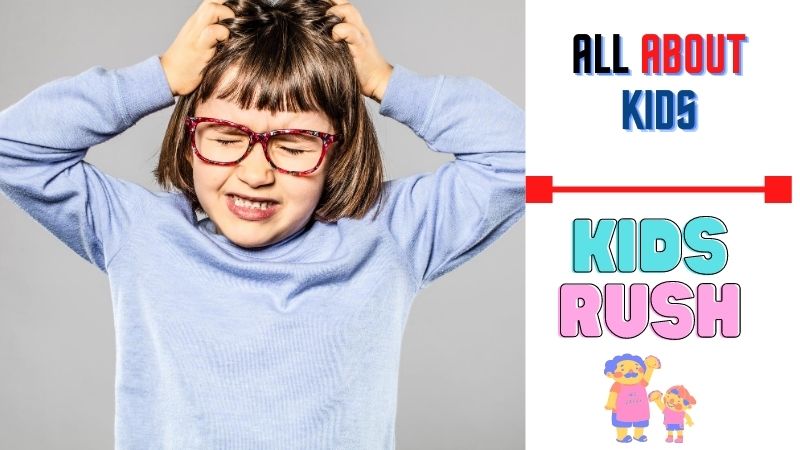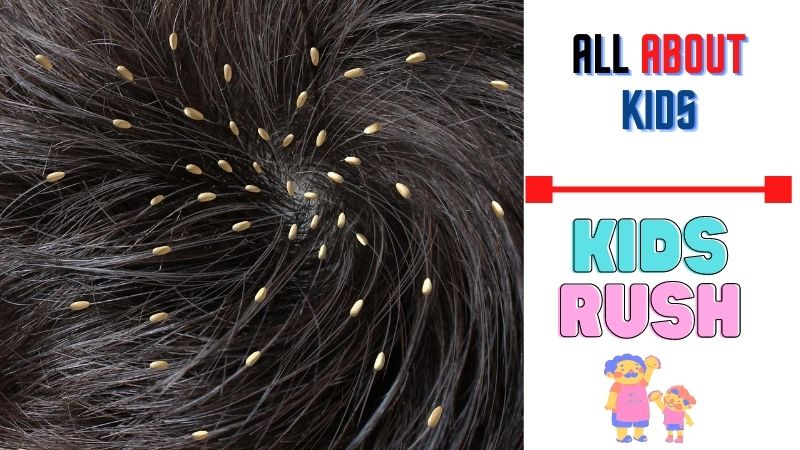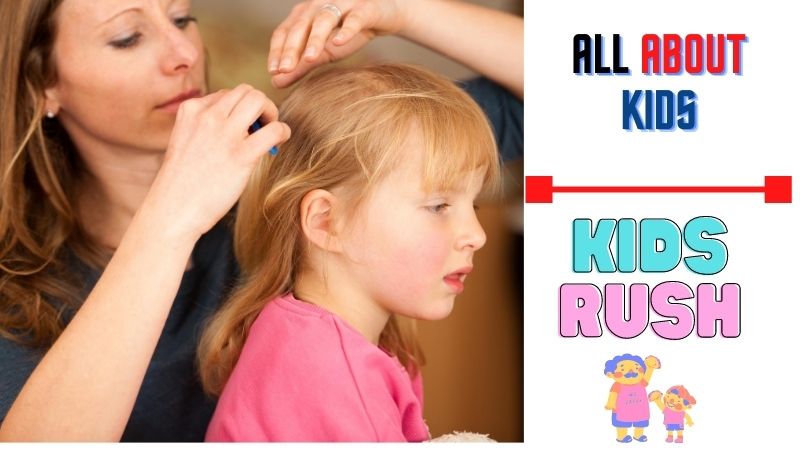Lice contagion in children is a very common problem which parents encounter. Head lice are insects devoid of wings (they do not fly) that live on the scalp of the human species, especially of children and young people, and although they do not transmit any disease, they can be itchy and unpleasant. All children can get head lice, regardless of their level of hygiene, and they should not be a cause for fear or shame.
Due to the extent of the infestation (we speak of an infestation in the case of parasites, such as lice, and infection in the case of viruses and bacteria), children will likely have lice at one time or another, and even They discover them at school and tell you that you must eliminate them. The instructions below are meant to show you how.
Lice contagion in children Facts

There are many popular beliefs about head lice and you need to know what is true. Lice infestation is the most common childhood illness after the common cold, and even more common than all other childhood infections combined. Children do not get lice because they are dirty or careless. Therefore, meticulous hygiene does not prevent lice infestation.
Most often, they are spread by direct head-to-head contact during play with infected partners (infection from combs or hats is much rarer). Lice no longer infest children with long hair. Although they are somewhat more common in girls, it is believed that it is because they tend to be more in direct contact with their friends during play than boys.
Lice do not fly or jump, which limits their spread to direct contact. However, they move very quickly through the hair and slip away easily. Infested children do not usually have a large number of lice, but only a few.
Symptoms of lice infestation

Most of the time, the infestation has no symptoms. Some children may be itchy, but it doesn’t appear right away, but rather days after being infected. There may be scratching lesions, so you should consult your pediatrician if you notice scratching erosions or redness of the skin of the scalp. You should also consult him if you detect an increase in lymph nodes in the neck area.
Knowing the life cycle of the louse will help you to better understand some aspects of the treatment. The adult female louse lays her eggs attached to the hair as close to the scalp as possible so that they are warmer and hatch better. At 8-10 days, the young louse hatches from the egg, which remains attached to the hair but is already empty.
It takes about 7-10 days for the young louse or nymph to become an adult, mate, and lay eggs. The half-life of a louse is around 30 days and a female louse can lay between 80 and 100 eggs in that period. Lice “eat” (bite) every 4 hours, blood from the scalp. Outside of man, they die in 24 hours, so objects are not a major source of contagion.
How to discover lice contagion in children?
Lice quickly sneak into hair when light is applied or styling is started, especially with dry hair. Therefore, the best way to discover lice is a thorough combing with wet hair, a special comb (with little distance between the prongs), a good light, and a white background (a towel on the shoulders or over the sink).
The adult female louse is the size of a sesame grain and is black or reddish-brown. The eggs are located mainly in the area behind the ears or back of the head. The “living” (with embryo) has a gelatinous gray color and is located near the scalp. The “voids” (nits) are white and located further from the hair root. The hair grows about 0.4 mm / day, and the egg takes about 8-10 days to empty (let the young louse come out) and is laid close to the root. Therefore, any egg located more than 1 cm from the scalp is almost certainly empty. Discovering eggs or nits is not a sure sign of an active infestation.
What is to be done?
The treatment of lice infestation is based on applying a pediculicide product and continuing to comb regularly. There are different types of these products, but not all are equally effective. Lice have become resistant to some. You should consult your pediatrician before starting treatment. In general, it is preferable to use lotions or gels than shampoos, since the action time is longer and the louse is more sensitive to the products if it is not covered with water. Follow its application instructions scrupulously, as otherwise, it may be more toxic or less effective. Repeat these treatments after a week regularly.
Nix® cream: apply to dry hair for 10-15 minutes, wait 30 minutes, and wash with the usual shampoo. Then comb with the comb (Lice Meister®), putting a white towel on the shoulders to check if the lice fall). Repeat at 12-24 hours. The hairstyle is very important to know if the treatment has been effective (do not forget that there is resistance).
One or two days after treatment, an exhaustive hairstyle should be carried out under the conditions described above. If lice did not obtain, one must assume that the treatment has been effective. If only one or two adult lice were obtained, it may be that there was a reinfestation just after treatment or that there is some resistance. Assuming that if you get several lice, especially if they are both young and adult, they are sure resistant and you should consider using a different pediculicide. It is not essential to remove the eggs (the embryos may be dead from the treatment), much less the nits, which will almost certainly be empty.
If you want to do it for aesthetic reasons, applying a solution of vinegar and water in equal parts for a few hours undoes the adhesive substance that binds them to the hair and helps the hairstyle remove them. Some children may continue to itch, even more, after treatment. It is due to an allergic reaction to lice products and dead eggs. If it causes a lot of discomforts, it may be necessary to consult your pediatrician, since there are medications to improve it.
How to prevent Lice contagion in children?
It is inadvisable to use pediculicide products (shampoos or lotions) as prevention. It is not clear that they are effective, they irritate the skin of the child’s scalp and, above all, they help the lice to become resistant. The best and safest prevention is to do a good hairstyle several times a week.
If we remember the life cycle of the louse, carrying out a good hairstyle 2 or 3 times a week we will be able to eliminate the adult lice and, above all, the young lice before they become adults and can lay eggs, thus interrupting the progression of the infestation. Repeated good combing is not only preventive but almost as effective as pediculicides in treating the infestation.
What to do with the objects and clothes of infected children?
As discussed above, lice live for a few hours outside of humans and do not infect objects. However, it is wise to remove them from the combs by immersing them in alcohol or boiling water. Wash your clothes in a hot water cycle (60 °) or dry clean or enclose in an airtight plastic bag for 2 weeks (time for a full cycle of possible lice or their eggs to complete and die). Domestic animals (dogs, cats, birds, etc.) do not acquire human lice and are not a source of contagion.
Frequent questions about lice contagion in children
Is it true that lice jump from one head to another?
No, lice do not jump or fly. They move from one head to the other if there is sufficient proximity between one person and another. They can also be transmitted through hats, helmets, or house clothes if there has been direct contact with the hair. No, lice do not jump or fly. They move from one head to the other if there is sufficient proximity between one person and another. They can also be transmitted through hats, helmets, or household clothing if there has been direct contact with the hair.
Are preventive treatments effective: colognes, shampoos, etc. to prevent children from getting lice?
“Preventive use” shampoos and colognes are not effective in preventing parasite transmission. The only effective “preventive” measures are the early detection of infestation cases, the simultaneous treatment of parasitized people who are in close contact (friends and schoolmates who sit together in class or the school cafeteria, children who play together in the yard, their parents and siblings) and finally the effective treatment of those affected and of the clothes that come into contact with their heads.
Is it true that alcohol and vinegar eradicate lice and are more effective than the “insecticidal” substances sold in pharmacies?
Neither vinegar nor alcohol is the most effective or least toxic treatments that we currently have. Soaking a special metal comb twice a day in vinegar diluted in water before carefully and repeatedly combing the parasitized child can help to detach the nits attached to the scalp. Provided it is after the pediculicide gel or lotion treatment suitable for eradicating the parasite.
It should be known that the mechanical action of the fine comb (“nit” type) is more effective to remove the nits than the application of more chemical substances, which will only achieve greater irritation of the skin in the treated area.
What is the most appropriate treatment for lice?
The right thing to do is: identify the cases well and use the treatment correctly. If possible, visualize the parasite or the presence of new nits in the hair. If there is a parasite, the itching symptom is evident, although in children with atopic skin the abuse of chemical substances can cause inflammation of the scalp and intense itching.
The right thing to do is to apply low toxicity pediculicidal substances (permethrin, pyrethrin) –and avoid Lindane, which is available in pharmacies without a prescription, toxic !! – in the form of foams, gel, or lotion, on dry hair, covering abundantly the head to the root of the hair, for a few minutes to several hours. A single-use plastic cap can help eradicate the parasite and shorten the duration of treatment.
How can lice be removed from hats, helmets, hats, or other clothing that has been in contact with hair?
Wash your clothes at 60 degrees or keep them in a sealed plastic bag for 10 days.
Are there people more likely than others to get lice?
No research proves that there are people with a greater predisposition than others towards this type of parasitosis. Compliance with basic measures of body hygiene, specifically daily combing or brushing and regular hair washing, surely has a positive influence against the infestation.
I do not know whether or not my child has lice on her head. What is there to look at?
If you are itchy and there is a precise epidemiological environment – there are lice in your class – you likely have head lice. If possible, the definitive thing is to visualize the parasite or insect or the presence of new nits, attached in the form of small whitish pods in the hair, 10-20 mm from the root.
There are live parasites, itching is an obvious symptom. In children with atopic skin, the abuse of chemicals can cause inflammation of the scalp and intense itching after the parasite has been eliminated.
Is it necessary to cut the hair to zero to eradicate the lice?
It is not essential, but facilitating daily combing with a fine metallic comb to eradicate nits is one of the basic measures for antiparasitic treatment. If there are curls and/or long hair there will be more tears than smiles …
Is it possible to get lice in areas other than the head?
Pediculosis capitis affects the hair on the head. Although it can rarely also infest the hair of the eyebrows or eyelashes. A similar parasite is pediculosis pubis, which infests pubic hair. Contracted through sexual intercourse or direct contact with parasitized bedding.
Why today, although the hygiene level of the population has increased, are there still lice in schools?
It is not known for sure, but different factors likely collaborate the current lifestyle, with the high rate of children who go to daycare from the first months and live closely together, the rush with which they often leave home in the mornings, sometimes without time to carefully comb the boys and girls and, finally, the lack of early detection or, in some cases, the lack of adequate treatment (not an only treatment on the spot, but also very strict follow-up during the following weeks to detection).

